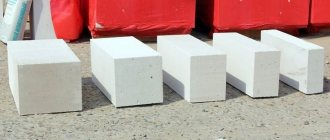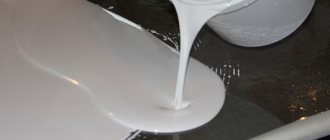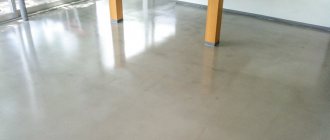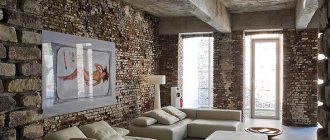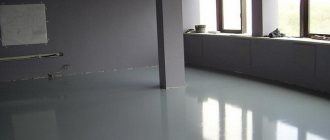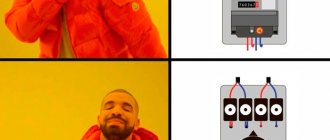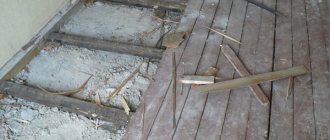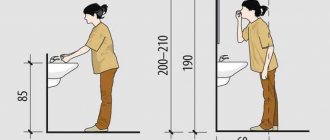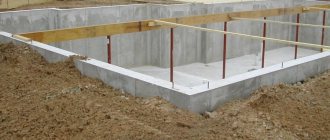The finishing floor covering is installed on a carefully prepared base. A leveling screed is laid on top of the floor slab, which after drying forms a smooth surface. However, the material shrinks, which significantly affects the quality of preparation. The curvature of the rough structure is compensated by the installation of a special material - a self-leveling self-leveling floor, the thickness of which is regulated by regulatory requirements and the manufacturer.
Self-leveling floor in the room
How to make self-leveling floors for tiles
Self-leveling flooring is one of the best materials for tiles, as it is characterized by high strength and evenness of the resulting base. It does not shrink and is protected from cracking and geometry changes. It is important to achieve a level surface before laying tiles. The optimal height difference is up to 2 mm per 1 linear meter of surface.
Self-leveling flooring has a number of advantages:
- use as a finishing coating;
- a good solution if a solid foundation is required;
- high strength characteristics;
- not susceptible to external factors;
- withstands severe loads;
- Ideal for ceramic tiles;
- minimum drying time.
Note! Self-leveling flooring is suitable for application on a solid base. But it is better to pre-treat it with a primer to prevent the material from flowing into microcracks in the base.
What affects consumption?
There are several factors that influence the expected mixture consumption. The composition, which is prepared in the factory, of course, has its original shelf life.
This is the first. The second point is that it’s very disappointing when the solution is diluted, the floor is poured, and you realize that the materials have already run out, you need to go to the store for the mixture. That is, it is easier to calculate the number of bags of the mixture in advance.
How is the mixture consumption determined? This is the total area of the room and the quality of the rough base, which is prepared in advance.
That is, if the rough base has complaints, it is uneven, more filling will definitely be needed.
But if, for example, the functions of a leveling material are performed by a cement or polyurethane screed, then the leveler is removed from the list of materials. And this is also an economic effect.
The purpose of pouring the composition also matters. To form a subfloor and then organize the finishing coating, the amount of material will be different than for pouring, for example, a 3D floor. Both dry and diluted mixtures will be required in different quantities.
Which self-leveling floor is better to choose for tiles?
There are two main options on sale - cement and gypsum self-leveling floors. Not all substrates are suitable for installation under tiles. The best choice would be a universal composition characterized by increased moisture-resistant qualities. In this case, there must be high compressive strength. If you plan to install it in a dry room without changes in humidity, you can choose a gypsum mixture.
Depending on your goals, you can choose the following mixture options:
| Thin-layer | They are usually used for decorative purposes as a finishing coating. But mixtures are offered that significantly increase mechanical stability. The thickness of the composition is offered from 1 to 5 mm. |
| Self-leveling | The thickness of the material does not exceed 2 cm. A self-leveling floor does not require serious effort, since the composition is almost independently distributed over the surface. The finished coating is so durable that it can be used in non-residential buildings without heating. |
| Highly filled | This material allows you to obtain a layer from 2 to 5 cm. Thanks to the use of inexpensive components, the cost of self-leveling flooring will be insignificant. |
Most often, self-leveling mixtures are used for domestic purposes. They are not difficult to use and do not require much effort when installing. It uses simple technology without expensive equipment.
Starting mixtures
Such materials are used when the floor is very curved and covering it with high-quality mixtures will be too expensive. Cement-based compounds are suitable for leveling. The maximum thickness without reinforcement is 5 cm. If you plan to install reinforcing mesh, it can be increased to 8–10 cm.
Experts recommend not making one thick layer, as it will take too long to dry; it is better to lay the cake in 2-3 parts.
Starting mixtures provide a reliable foundation for high-quality coating
Self-leveling flooring technology
Leveling the floor before laying tiles requires preliminary preparation of the surface. It is important to choose the appropriate material, prepare a flat concrete base, and prime the surface.
The following instructions are used:
- Immediately after preparing the mixture, pour it onto the floor surface. Fill starting from the far corner of the room. Ensure continuous filling of the composition. For this reason, it is better to work together. The maximum break is 20 minutes.
- Level the solution to the desired level. It should be the same throughout the room.
- Use an aerobic roller to roll the mortar layer after leveling. They need to work for at least 10 minutes without removing it from the solution.
Mix the solution
Pour onto prepared surface
Level with a needle roller
Done
Dmitry Novoselov
Author and expert of our site. He regularly shares his wealth of experience in construction and renovation.
Ask a Question
When working, use special shoes or spiked boot mounts. They are of sufficient height so as not to damage the surface being treated.
If everything is done correctly, the result is noticeable almost immediately. The surface is smooth, without any damage or uneven areas. Further work with the tiles can be continued after the material has completely dried, which is indicated on the packaging with the mixture.
Thickness of self-leveling floor under tiles
Before starting work, calculate the material costs. The cost of repairs will largely depend on this. The main influencing factor is the thickness of the layer. It should be selected taking into account a number of features:
| Minimum thickness | It is taken into account in accordance with the recommendations on the packaging left by the manufacturer. On average it is up to 1 mm. |
| Load level | The vibration effect and the degree of traffic in the room are taken into account. If high strength and wear resistance are required, you will have to order more material. |
| Surface curvature | The fill layer will be thicker for non-standard rooms. |
For an ordinary apartment or house, a large thickness (about 5 mm) is not required. It is important that the concrete base is level. Waterproofing compounds are also used in the bathroom to ensure complete safety against leaks. The thickness of the highly filled layer is on average 8 mm.
Low temperature conditions
As we said, the mixtures are for use in low temperatures and are made from methyl methacrylic resin. The composition also contains various additives that improve the characteristics of the mixture. In order to ensure maximum resistance to temperature changes, it is necessary to maintain a layer thickness of 5-7 mm.
Such coatings are usually made in refrigeration chambers, in rooms adjacent to them. And let’s gradually move on to how thick the self-leveling floor should be in residential buildings.
How long does it take for a self-leveling floor to dry?
To do the job correctly with your own hands, it is important to know the drying period of the bulk mixture. The solution begins to set after 15-20 minutes. After this, it takes another 8 to 10 hours to gain strength. During this period, it is allowed to step on the surface, although it is not yet advisable to do this.
Manufacturers indicate an average drying period of 1 to 3 days. The exact period depends on the height of the coating and the total area of the room. After the drying process is complete, you can begin laying ceramic tiles. If the mixture is prepared correctly, there will be no difficulties during the drying period. A thin layer coating in most cases dries within 24 hours.
How to install self-leveling floor
You will make self-leveling floors correctly if you dilute the composition in accordance with the manufacturer's requirements. To prepare the mixture, pour the powder from the bag into a specially prepared container. The most convenient option is a large bucket designed for construction work.
Add enough water to the mixture. At the same time, as you fall asleep, it is important to stir simultaneously. It is more convenient to perform this work in parallel, for which you will need an assistant.
It is important to take the ratio of water and dry composition in strict accordance with the manufacturer's recommendations. Increased water may disrupt the hydration process. In this case, strength characteristics and resistance to heavy loads are lost. If it is deficient, the composition will be too dense and will not be distributed correctly over the surface.
The most important component is following the recommendations. The result is the following:
- It is better to stir the mixture using a puncher with a special attachment, as the fastest possible effect is obtained;
- the finished composition obtains a creamy and homogeneous texture;
- The mixture is completely ready for pouring after repeated mixing.
Lay the self-leveling floor before finishing the walls and ceiling. This will avoid the need to clean surfaces after completion of work. If wallpaper or painting is chosen as wall decoration, you will have to completely redo the decorative layer.
Main characteristics of self-leveling compounds
According to Russian building codes and regulations, the cross-section of the screed must meet the parameters of 20-150 mm. Mobile or highly mobile dry compositions differ:
- viscosity. Contains gypsum and cement;
- filler The composition contains perlite and quartz sand;
- additional additives. Components with modifying and plasticizing characteristics, additives contribute to more convenient laying of the material, improve the spreadability of the solution, speed up the drying time, and reduce the shrinkage rate.
Self-leveling floors also include decorative finishing polymer mixtures. The compositions represent a series of household 3D and industrial protective coatings, which in composition and properties are similar to varnish for wooden and stone surfaces.
Photo: 3D self-leveling floor
Contains film-forming components based on high-strength resinous substances:
- acrylic;
- polyurethane;
- epoxy.
Apply with a roller or spatula onto a previously prepared mineral base. After hardening, the result is a varnish coating that is extremely resistant to abrasive, impact and other physical negative loads.
Do you need a self-leveling floor under tiles?
Whether it is necessary to make self-leveling floors before installation is up to you to decide. This will provide high strength and protect the base from possible damage. This is especially important if a significant load on the floor is planned - installation of heavy furniture, high traffic flow of the room. When done correctly, the result is a reliable and durable coating.
Another possible method is to pour a concrete base along the beacons. In this case, it is difficult to obtain a perfectly flat surface, since the mixture will not be leveled well. This increases the drying time of the material. In many cases it reaches up to 4 weeks.
A positive property of self-leveling floors is the minimum amount of preparatory work. They do not require large financial and labor costs. Simply prepare the required amount of mixture and apply to the surface. You can start laying tiles within a few days. It is performed using standard technology.
This way, you can level the floor yourself before laying ceramic tiles. To do this, select a high-quality mixture for self-leveling flooring. It will provide high strength and reliability for many years. The tile holds well on the surface, does not crack or shift under load.
